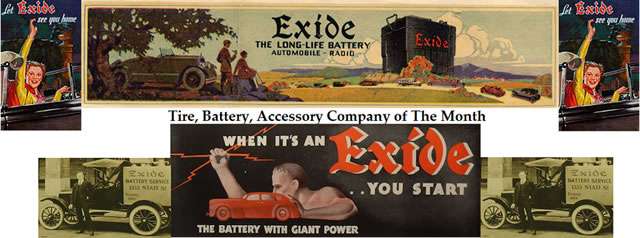A recent post sparked my interest to start a new category of "company of the month postings" As Disscussed with Jim, I will host a new company every month relating to the Tire, Battery, and Accesory part of the gas and oil hobby. For those of you who are not familiar with this showcase please feel free to post pictures relating to the compnay or any other company history you may come across. The feature company this month is Exide batteries.

Company History From Exide:
The Electric Storage Battery Company
The evolution of what is now Exide Technologies began with creation of The Electric Storage Battery Company, founded in 1888 by W.W. Gibbs. As vice president of the United Gas Improvement Company, a Philadelphia gas lighting firm, Gibbs recognized that electricity had great potential as a source for lighting, and as such, posed a threat to gas. Gibbs formed the Electric Storage Battery Company to create a dependable mechanism for storing power so electric lighting companies could provide services to their customers if and when it was necessary.
Realizing that a better storage battery was a necessary first step, Gibbs purchased the ideas and patents of French inventor, Clement Payen, to transform good ideas about storage batteries (then widely referred to as "Pickled Amperes") into thoroughly reliable commercial products. With the development of the storage battery, or the "Chloride Accumulator," the Electric Storage Battery Company brought the electric lighting industry to a new level.
The "Chloride Accumulator"
In 1890, the Electric Storage Battery Company installed the first practical storage battery at the Germantown Electric Lighting Company in Philadelphia. The battery furnished the lighting current, while a dynamo charged the battery. Soon after, the battery company received a request for 13,000 cells to power six new electric streetcars for the Lehigh Avenue Railway Company in Philadelphia. These streetcars became the first self-propelled vehicles to challenge the supremacy of the horse. Throughout the 1890s, the demand for storage batteries increased, forcing the Electric Storage Battery Company to move to larger facilities.
The possibilities for storage batteries continued to grow. The Pullman Company used Chloride Accumulators to light a few of its luxury railroad cars, and small batteries were sold to operate electric fans, sewing machines and phonographs. In 1898, batteries powered the first submarine in the U.S. Just before the turn of the century, Electric Storage Battery 2
Company batteries were used as power sources in electric locomotives, streetcars, passenger cars, surface boats and telephone exchanges, and for the nation's first automatic switching and signaling systems for railroads.
As the new century dawned, electric taxicabs first appeared in many large cities. They became so popular that The Electric Storage Battery Company developed a product of greater capacity and less weight especially for the "Ply-for-hire" trade. This new battery, introduced in 1900, was the first to bear the trade name "Exide," short for "Excellent Oxide."
The introduction of the electric carriage as a private passenger vehicle, primarily for town travel, heralded batteries as a means of replacing horsepower. The second development stemmed from a common health problem caused by cars at the time: motorists' broken arms. As a driver hand cranked his engine, the crank often swung back violently, injuring the driver's arm. Efforts to eliminate dangerous engine cranking led to the development of battery-started vehicles. The 1912, Cadillac became the first battery-started car with an internal combustion engine, produced under cooperative development between The Electric Storage Battery Company and Charles F. Kettering. The Exide battery also supplied power for lighting and ignition in this model. The functions of starting, lighting and ignition are the origin of today's battery industry term SLI, referring to automotive batteries.]

